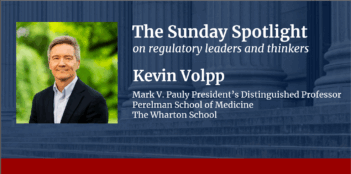
New research paper examines the challenges and opportunities of a behavioral approach to regulation.
President Obama’s Executive Order 13563 for the first time in history encouraged administrative agencies to draw upon the behavioral sciences in the design and implementation of new regulations. To date, however, agencies have received no practical guidance on how to integrate behaviorally inspired regulatory instruments into the regulatory process. How can public administrators transform behavioral research findings into operational regulatory tools while ensuring protections for citizens in a new, “nudging” state?
In a forthcoming paper, New York University School of Law’s Alberto Alemanno and the University of Milan’s Alessandro Spina analyze how empirical findings from behavioral research can complement traditional regulation.
From its mid-20th century origins in the late Herbert Simon’s theory of bounded rationality to Richard Thaler and Cass Sunstein’s recent best-seller, Nudge, the idea that humans make imperfect decisions has become mainstream, say Alemanno and Spina. Behavioral research has given scientists ever-greater insight into the cognitive biases, fallacies, and heuristics driving human action. Moreover, the argument that regulation must consider how targeted people respond in order to be effective has caught fire among academics and policy architects alike, according to the authors.
In spite of policymakers’ and agencies’ growing enthusiasm for behaviorally driven regulation, a clear legal framework for turning behavioral insights into operational regulatory tools is largely absent, Alemanno and Spina say. Without a fully transparent mechanism for incorporating behavioral research findings into policy-making, the authors argue, the burgeoning field’s potential to help policy makers will be lost. Alemanno and Spina believe that both EU and U.S. regulators could benefit from systematic integration of behavioral research into policy creation.
For examples of regulatory application of behavioral insights, Alemanno and Spina point to Article 22 of the European Union’s (EU) Directive on Consumer Rights, which relies on research on human inertia, framing, and status quo bias to limit the use of pre-checked boxes. They also discuss the EU’s E-Privacy Directive, which requires users’ explicit consent via opt-in for third-party processing of cookies. Despite these recent instances of behavioral regulation, the authors say, EU regulators have used such research on a largely ad hoc basis.
In the United States, Section 4 of Executive Order 13563 encourages agencies to consider regulatory approaches such as default rules, disclosure, and simplification that nudge citizens toward better choices while allowing them to retain flexibility and liberty of choice. However, without guidance to facilitate federal agencies’ integration of behavioral insights into new regulations, agencies are unlikely to use such findings systematically, with marginal effect on the activities of public administrations, claim Alemanno and Spina.
Alemanno and Spina propose a number of policy recommendations to incorporate behavioral research findings into the regulatory process. First, they suggest a general requirement directing public administrators to consider a set of formalized regulatory tools such as disclosure requirements, default rules, and simplification at the pre-rulemaking or pre-legislative stage. According to the authors, such a comprehensive mandate would not only provide a more principled, consistent, and effective method of operationalization but also would ensure accountability and transparency.
Responding to critics who argue that cognitive studies and behavioral observations inside the lab may not match human behavior in the real world, Alemanno and Spina also advise that behaviorally informed measures be tested via a specific procedural mechanism: a randomized controlled trial (RCT). Widely known as the gold standard in clinical research design for evaluating the effects of interventions, RCT minimizes sources of bias through random allocation of participants to intervention and control groups. Alemanno and Spina thus propose the extension of RCTs from the clinical to the public policy sector. In fact, by assessing the on-the-ground impact of proposed regulatory measures, RCTs could serve to complement agencies’ traditional benefit-cost analyses, the authors say.
Behaviorally informed regulation, however, is not without concerns, Alemanno and Spina caution. While critics frequently point out that nudging cannot be considered “law” in the strict sense because it is a choice-preserving alternative to traditional command-and-control regulation, the authors argue that such regulation is rooted in a materially different conception of power. The power of behavioral regulation rests upon influence and persuasion, rather than coercion. Because such “smart thinking” regulation seeks to discretely alter human behavior in very precise ways, Alemanno and Spina say, the need for appropriate checks, controls, and restrictions on its use is compelling. Although regulatory nudges may be less burdensome and prohibitive than traditional government actions, Alemanno and Spina say that administrative agencies’ attempts at using behavioral findings to influence citizens’ choices and modify their cognitive framework may interfere with individual autonomy, including freedom of expression and privacy. For example, it might be troubling if an agency used profiling to personalize default rules on the basis of individuals’ past choices, rather than applying default rules to the entire population. The authors claim that it is unclear whether current administrative law instruments offer adequate protection against possible abuses of behavioral regulation.
Alemanno and Spina explore the potential of global administrative law to provide sufficient safeguards by examining three key principles: legality, impartiality, and judicial review. The authors explain that the principle of legality seeks to control discretion and circumscribe excessive power by requiring that all administrative decisions conform to the law. However, the fundamental strength of behaviorally inspired regulation rests precisely upon its flexibility and adaptability; that is, its very nature resists formalization. Policy makers are therefore stuck in a Catch-22: while formalizing behaviorally inspired regulation may divest it of the very defining features that make it so advantageous, failure to formalize may result in “arbitrary and capricious action.” Furthermore, the use of behaviorally inspired devices such as “framing” may conflict with the duty of impartiality, which requires that governments provide impartial and reliable information to their citizens. Finally, Alemanno and Spina claim that behavioral regulation’s persuasive nature, informal enforcement mechanisms, and absence of a binding element may function to camouflage its legal effects, thereby potentially enabling it to evade judicial review.
To provide a concrete example of these problems, the authors point to an incident from the United Kingdom, where unemployed citizens were threatened with a loss of benefits if they refused to take a psychological test devised by Downing Street’s “behavioural insights” or “nudge” unit. The test purported to reveal a test taker’s strengths through their responses to a questionnaire, but the test was later revealed to be a “sham.” Test-takers answering every question in the opposite way could reportedly end up receiving the same results, suggesting that the aim of the “test” was simply to raise the self-esteem of the unemployed.
Alemanno and Spina conclude that while the use of behaviorally informed, “smart thinking” regulation to complement classical regulatory instruments may lead to more effective and innovative regulatory policies in certain circumstances, these approaches may also sometimes raise significant legal concerns. Policy makers and administrative agencies would do well to develop a fully operational legal framework which not only ensures that behavioral findings inform the regulatory process but also fully protects citizens’ fundamental rights. With a robust framework in place, the authors assert, administrative law can begin to successfully reap the benefits of the behavioral sciences.



